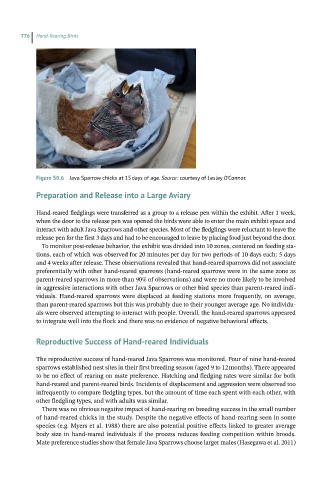Page 773 - Hand rearing birds second
P. 773
776 Hand-Rearing Birds
Figure 50.6 Java Sparrow chicks at 15 days of age. Source: courtesy of Lesley O’Connor.
Preparationand Releaseintoa LargeAviary
Hand‐reared fledglings were transferred as a group to a release pen within the exhibit. After 1 week,
when the door to the release pen was opened the birds were able to enter the main exhibit space and
interact with adult Java Sparrows and other species. Most of the fledglings were reluctant to leave the
release pen for the first 3 days and had to be encouraged to leave by placing food just beyond the door.
To monitor post‐release behavior, the exhibit was divided into 10 zones, centered on feeding sta-
tions, each of which was observed for 20 minutes per day for two periods of 10 days each: 5 days
and 4 weeks after release. These observations revealed that hand‐reared sparrows did not associate
preferentially with other hand‐reared sparrows (hand‐reared sparrows were in the same zone as
parent‐reared sparrows in more than 90% of observations) and were no more likely to be involved
in aggressive interactions with other Java Sparrows or other bird species than parent‐reared indi-
viduals. Hand‐reared sparrows were displaced at feeding stations more frequently, on average,
than parent‐reared sparrows but this was probably due to their younger average age. No individu-
als were observed attempting to interact with people. Overall, the hand‐reared sparrows appeared
to integrate well into the flock and there was no evidence of negative behavioral effects.
ReproductiveSuccessof Hand-rearedIndividuals
The reproductive success of hand‐reared Java Sparrows was monitored. Four of nine hand‐reared
sparrows established nest sites in their first breeding season (aged 9 to 12 months). There appeared
to be no effect of rearing on mate preference. Hatching and fledging rates were similar for both
hand‐reared and parent‐reared birds. Incidents of displacement and aggression were observed too
infrequently to compare fledgling types, but the amount of time each spent with each other, with
other fledgling types, and with adults was similar.
There was no obvious negative impact of hand‐rearing on breeding success in the small number
of hand‐reared chicks in the study. Despite the negative effects of hand‐rearing seen in some
species (e.g. Myers et al. 1988) there are also potential positive effects linked to greater average
body size in hand‐reared individuals if the process reduces feeding competition within broods.
Mate preference studies show that female Java Sparrows choose larger males (Hasegawa et al. 2011)

